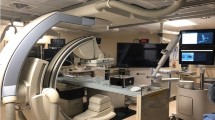Abstract
Objectives
Spread through air spaces (STAS) as a pattern of invasion in lung adenocarcinomas had been recognized by WHO in 2015. Moreover, STAS was associated significantly with aggressive micropapillary or solid components when presented predominant pattern in lung adenocarcinomas, which had a poor prognostic significance. Small amounts of micropapillary or solid with components could also reduce overall survival and recurrence-free survival but its impact on STAS is unknown now. Some studies have demonstrated manipulations of surgeons and pathologists could affect STAS but the degree of these impacts is not clear.
Materials and methods
We reviewed resected small (≤ 2 cm) stage I invasive lung adenocarcinomas by thoracoscopic surgery at our institution from January 2017 to October 2018 (n = 277). Micropapillary or solid pattern was considered to be present when the subtype occupied at least 1% of the entire tumor. Lobectomy and segmentectomy were performed using three portals thoracoscopic surgery. Statistical analysis was performed to analyze the correlations of STAS and clinicopathological characteristics. Moreover, we also analyzed the correlated factors of STAS in solid nodules.
Results
STAS was found in 59 of 163 (36.2%) lobectomy cases and 27 of 114 (23.7%) limited resection cases. Lobectomy group showed a higher incidence of STAS compared with limited resection group (p = 0.027), but the difference was disappeared in multivariate analysis, which showed that STAS was significantly correlated to solid nodules and presence of high grade histologic subtype (mircopapillary or solid). However, both lobectomy and presence of high grade histologic subtype were significantly correlated with STAS in solid nodules.
Conclusions
The small amounts of high grade histologic subtypes were also associated with STAS. Thoracoscopic surgery could affect STAS to some degree.


Similar content being viewed by others
References
American Joint Committee on Cancer (2017) Lung. In: Rami-Porta R, Asamura H, Travis WD, Rusch VW (eds) AJCC cancer staging manual, 8th edn. Springer, New York, pp 431–456
Blaauwgeers H, Flieder D, Warth A et al (2017) A prospective study of loose tissue fragments in non-small cell lung cancer resection specimens. Am J Surg Pathol 41:1226–1230
Cha MJ, Lee HY, Lee KS et al (2014) Micropapillary and solid subtypes of invasive lung adenocarcinoma: clinical predictors of histopathology and outcome. J Thorac Cardiovasc Surg 147:921–928
Dai C, Xie H, Su H et al (2017) Tumor spread through air spaces affects the recurrence and overall survival in patients with lung adenocarcinoma > 2–3 cm. J Thorac Oncol 12:1052–1060
Diaz LK, Wiley EL, Venta LA (1999) Are malignant cells displaced by large gauge need core biopsy of the breast? AJR Am J Roentgenol 173(5):1303–1313
Kadota K, Nitadori J, Sima CS et al (2015) Tumor spread through air spaces is an important pattern of invasion and impacts the frequency and location of recurrences after limited resection for small stage I lung adenocarcinomas. J Thorac Oncol 10:806–814
Liu L, Che G, Pu Q et al (2010) A new concept of endoscopic lung cancer resection: single-direction thoracoscopic lobectomy. Surg Oncol 19(2):e71–e77
Lu S, Tan KS, Kadota K et al (2017) Spread through air spaces (STAS) is an independent predictor of recurrence and lung cancer-specific death in squamous cell carcinoma. J Thorac Oncol 12:223–234
Oizumi H, Kato H, Endoh M et al (2014) Techniques to define segmental anatomy during segmentectomy. Ann Cardiothorac Surg. 3:170–175
Onozato ML, Kovach AE, Yeap BY et al (2013) Tumor islands in resected early-stage lung adenocarcinomas are associated with unique clinicopathologic and molecular characteristics and worse prognosis. Am J Surg Pathol 37:287–294
Shiono S, Yanagawa N (2016) Spread through air spaces is a predictive factor of recurrence and a prognostic factor in stage I lung adenocarcinoma. Interact Cardiovasc Thorac Surg 23:567–572
Shiono S, Endo M, Suzuki K et al (2018) Spread through air spaces is a prognostic factor in sublobar resection of non-small cell lung cancer. Ann Thorac Surg 106:354–360
Thunnissen E, Blaauwgeers HJ, de Cuba EM et al (2016) Ex vivo artifacts and histopathologic pitfalls in the lung. Arch Pathol Lab Med 140:212–220
Toyokawa G, Yamada Y, Tagawa T et al (2018) Significance of spread through air spaces in resected pathological stage I Lung adenocarcinoma. Ann Thorac Surg 105:1655–1663
Travis WD, Brambilla E, Noguchi M et al (2011) International Association for the Study of Lung Cancer/American Thoracic Society/European Respiratory Society International Multidisciplinary Classification of Lung Adenocarcinoma. J Thorac Oncol 6(2):244–285
Travis WD, Brambilla E, Nicholson AG et al (2015) The 2015 World Health Organization classification of lung tumors: impact of genetic, clinical and radiologic advances since the 2004 classification. J Thorac Oncol 10:1243–1260
Uruga H, Fujii T, Fujimori S et al (2017) Semiquantitative assessment of tumor spread through air spaces (STAS) in early-stage lung adenocarcinomas. J Thorac Oncol 12:1046–1051
Warth A (2017) Spread through air spaces (STAS): a comprehensive update. Transl Lung Cancer Res 6:501–507
Warth A, Muley T, Kossakowski CA et al (2015) Prognostic impact of intra-alveolar tumor spread in pulmonary adenocarcinoma. Am J Surg Pathol 39:793–801
Zombori T, Nyári T, Tiszlavicz L et al (2018) The more the micropapillary pattern in stage I lung adenocarcinoma, the worse the prognosis-a retrospective study on digitalized slides. Virchows Arch 472:949–958
Funding
This study was supported by National Natural Science Foundation of China (Grant No. 81672291; No. 31071210) to Yi-Dan Lin.
Author information
Authors and Affiliations
Corresponding author
Ethics declarations
Conflict of interest
The authors have stated that they have no conflicts of interest.
Ethical approval
This article does not contain any studies with human participants or animals performed by any of the authors.
Informed consent
The study was approved by our institutional review board and informed consent was waived because of retrospective study.
Additional information
Publisher's Note
Springer Nature remains neutral with regard to jurisdictional claims in published maps and institutional affiliations.
Rights and permissions
About this article
Cite this article
Song, T., Jiang, L., Zhuo, Z. et al. Impacts of thoracoscopic surgery and high grade histologic subtypes on spread through air spaces in small stage I lung adenocarcinomas. J Cancer Res Clin Oncol 145, 2375–2382 (2019). https://doi.org/10.1007/s00432-019-02972-6
Received:
Accepted:
Published:
Issue Date:
DOI: https://doi.org/10.1007/s00432-019-02972-6




